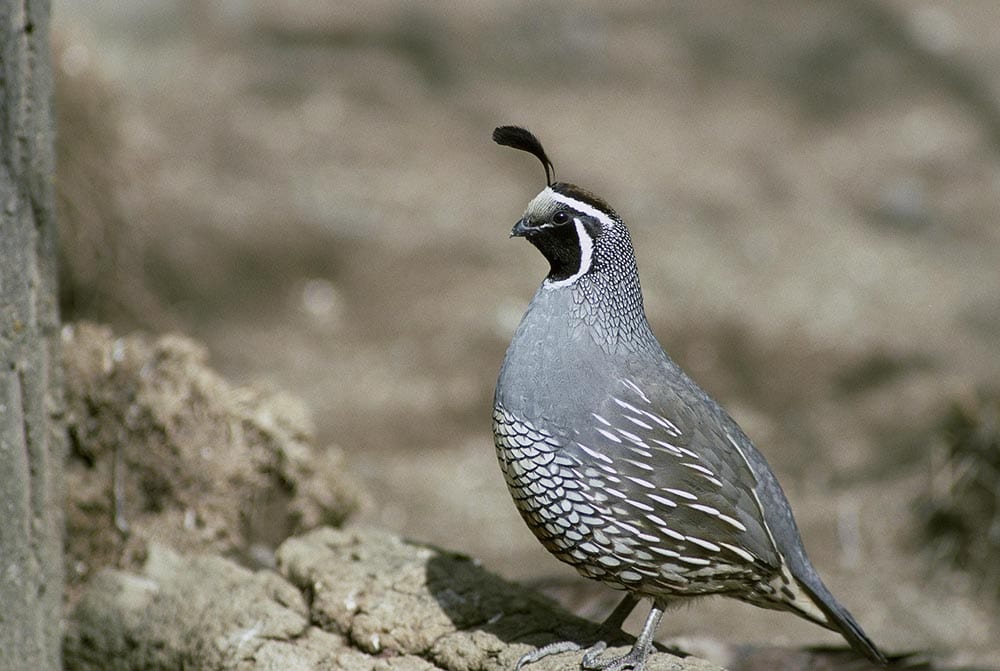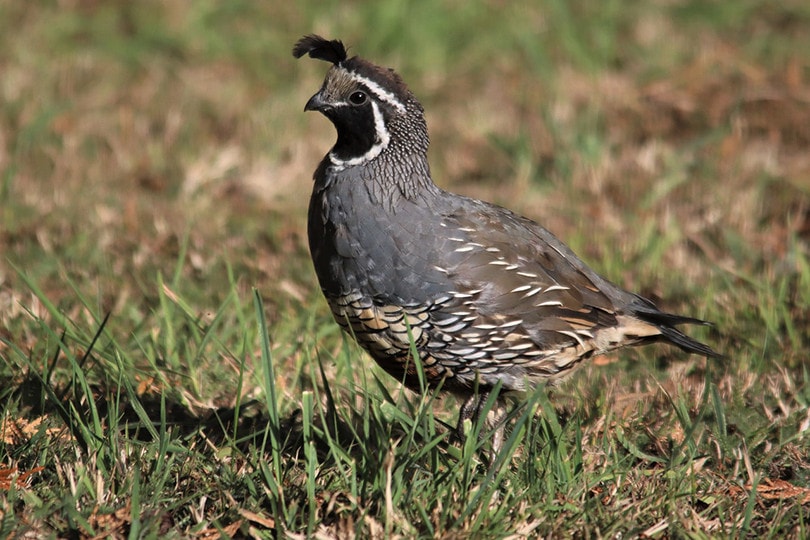What Is California’s State Bird? How Was It Decided?
Last Updated on

If you were to wager a guess which bird was chosen as the state bird of California, you would probably think the California Condor was the top bird. With its huge size, majestically swooping over magnificent valleys, the bird has become an icon of the state in recent decades and a symbol for conservation.
Alas, you would be mistaken. The actual state bird of California is the California quail, also known as the Valley quail. Growing to about 10 inches in length, this plump little bird can be seen rummaging among the underbrush, distinguishable by the iconic quail plume, like an apostrophe sticking out of its head.

How Was the California Quail Chosen As the State Bird?
California adopted the state bird in the 1931 legislative session with unanimous passage of Assembly Bill 776 The bird had been put forward as a state emblem by the Audubon Society. Though few records of this decision-making process were kept, we know that the bird had a reputation for resourcefulness and adaptability These qualities, possibly invoking attributes of the state’s pioneer history, drew the Audubon Society to the California quail.
The California quail was then, as it is still now, popular with sport hunters as a game bird. The birds were part of the Gold Rush miners’ diet and were hunted by California’s indigenous people before that. State emblems are often chosen to highlight industries or activities that are an important part of a state’s history or character. The Audubon Society was a sportsman’s organization and a conservation organization, so it’s likely that another reason it chose the quail was to promote the sport hunting industry in the state.

Information
Appearance
The California quail are shaped like a pigeon with a forehead tassel. They have a 14-inch wingspan and grow no larger than 10 inches, and their backs and chest are a gray-blue in males and more of a gray-brown in females. The sides and bellies of both sexes are light brown, accentuated with white streaks on the sides and a scaly pattern on the belly. Males have a black face and a dark brown cap on top, whereas females have grayish-brown colors on their heads.
Habitat
The California quail avoids the mountains and the deserts (hence its other name, the Valley Quail), preferring lowland habitats throughout the state—chaparral, oak woods, coastal scrub, and riparian areas. Its range extends from Baja California in the south to Oregon and the Plateau region of Washington in the north. The birds are somewhat shy but can often be seen in suitably wild areas close to human habitation
Behavior
Throughout much of the year, California quail live in large coveys of 75 –200 birds. They’re mostly ground dwellers and spend their days scratching and foraging through leaf litter, looking for their staple foods of seeds, acorns, berries, flower buds, or invertebrates. Surprisingly, they tend not to drink water as they get all the moisture they need from the foods they eat. California quail only visit water sources during the driest parts of the summer.
They can fly to escape predators, but they prefer to try and run away first, which they can do with remarkable speed. A curious behavior of the quail is its propensity for dust baths. In the morning, coveys will find an open patch of recently turned dirt, burrow into it with their bellies, and proceed to rustle around and clean their feathers while filling the air with dust clouds. Birders often track California quail by searching for the tracks left behind in the dirt.
Mating
When the breeding season begins in May, California quail couples leave the covey and make a nest in the ground that’s hidden in the underbrush and often covered with grass or leaves. The male quail stands guard, feeds and protects the female from predators, and keeps other quail away.
A female can lay around 14 eggs but may end up incubating as many as 28. This results from a behavior known as “egg dumping” whereby a female quail, or even another bird species, will lay her eggs in another quail’s nest. Families of California quail with babies following in a line like ducklings are a common springtime sight in California.

Fun Facts About the California Quail
- Despite being territorial during the nesting and egg-laying processes, neighboring broods of quail will sometimes mingle their chicks and raise them communally after hatching. Adults that share parenting responsibilities like this live longer than pairs that raise their chicks individually.
- Quail pairs call to each other antiphonally. This means that the male and the female have different calls that alternate with each other in closely matching patterns.
- California quail populations have fluctuated significantly. In 2017, only one California quail could be found in the city of San Francisco. Local birders named it “Ishi” after the famed last known member of California’s Native Yahi tribe.
- The California quail has been introduced to many areas around the world, including Europe, Hawai’i, South Africa, New Zealand, and many parts of South America. Some of these introductions, such as New Zealand and South Africa, occurred during gold rushes.
- The California quail has been partially domesticated, with some people keeping them as pets and breeding them in captivity. However, you should never capture a wild bird as a pet; always purchase one from a reputable breeder.
See also:
Featured Image Credit: PublicDomainImages, Pixabay
About the Author Robert Sparks
Robert’s obsession with all things optical started early in life, when his optician father would bring home prototypes for Robert to play with. Nowadays, Robert is dedicated to helping others find the right optics for their needs. His hobbies include astronomy, astrophysics, and model building. Originally from Newark, NJ, he resides in Santa Fe, New Mexico, where the nighttime skies are filled with glittering stars.
Related Articles:
What Is the Best Binocular Magnification for Hunting? Optical Features Explained
10 Types of Hummingbirds in Arkansas (With Pictures)
8 Types of Hummingbirds in Nebraska (With Pictures)
5 Types of Hummingbirds in Idaho (With Pictures)
3 Types of Hummingbirds in Mississippi (With Pictures)
8 Types of Hummingbirds in Kansas (With Pictures)
5 Types of Hummingbirds in West Virginia (With Pictures)
5 Types of Hummingbirds in Ohio (With Pictures)
